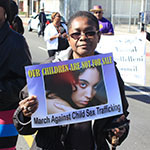Industrial District Green project leader Katherine McNenny shares her story on how and why she started the nonprofit organization.
A non-profit organization that helps underprivileged kids ages 8-21 years old in South L.A. APCH prides itself on being a safe haven for children.
Sex trafficking in District 8 affects each and every person, child, church member and activist. This is an issue that is increasing as more and more children are being taken advantage of and victimized by pimps in the area.
Over 40 states have officially recognized the Armenian Genocide that took place 99 years ago, but what will it take to get the U.S. to recognize it at a national level?
By Gabi Duncan
Downtown Los Angeles’ Industrial District is slowly getting a green makeover with the help of a local nonprofit called Industrial District Green. The organization’s mission is to plant greenery in various industrial neighborhoods, including Skid Row, the Arts District, the Produce District and the Toy District.
The idea began when project leader Katherine McNenny decided to plant trees outside of her apartment building in Skid Row a few years ago. She immediately noticed the severe lack of trees in the surrounding area and wanted to do something about it.
“As soon as I moved in, I started thinking about how to put trees on the sidewalks,” said McNenny. “And, it was a process. I did not have any idea how to do it, but I knew it needed to be done.”
Her efforts quickly garnered attention from other residents and community members. One of her neighbors Hal McMath took notice and urged McNenny to start the nonprofit because he also recognized the need for greening in the industrial neighborhoods.
“All we have are these barren streets, blank walls and impervious pavement everywhere,” said McMath, who serves as project advisor for the organization. “We are hoping that by building up the canopy, we can address multiple quality of life issues, as well as sustainability issues.”
The entire eastern portion of Downtown is devoid of almost any tree canopy whatsoever. To tackle that hurdle, McNenny and McGath teamed up with Gabrielle Newmark, a landscape architect with 18 years of street planting experience. Together, they have hosted additional tree plantings through the organization in the Arts District, Skid Row and Little Tokyo.
“Our environmental goal is to reduce the amount of concrete and hardscape and make it a more habitable place for everyone that lives there,” said Newmark.
Industrial District Green is comprised of three main programs: green planning, green build and maintenance. However, maintenance is the most critical piece of the puzzle and remains one of the organization’s biggest challenges.
“The city of Los Angeles does not provide any maintenance money, which seems crazy because it gets so hot in the summer, and you need to water a new tree for five years,” said McNenny. “It is incredibly difficult to get water to the trees in a dense, urban environment like Downtown.”
McNenny singlehandedly waters the trees in her neighborhood with a wheelbarrow and a bucket multiple times per month, which she describes as a struggle. Typically, newly planted trees require about 15 gallons of water within the first three months, so extra help is essential to ensure all the trees will not dry up and die.
Industrial District Green Photo Essay
“The challenge is basically selling people on maintenance plans, and maintenance plans just are not sexy,” said McMath. “People want to contribute to putting trees in the ground, but the unglamorous part is caring for those trees for a good five years until they get established.”
The organization is in the process of establishing a funded maintenance program that will guarantee the trees grow to maturity. The leaders have teamed up with Chrysalis, a nonprofit that helps people coming out of poverty, homelessness and the criminal justice system to find and keep employment.
“The plan would be to use Gabrielle and Katherine’s expertise, and then supply them with people that can help with the labor,” said Chrysalis Vice President Trevor Kale. “We would direct the crews to get the work done to keep the trees healthy.”
Industrial District Green has gained significant support and interest recently, both verbally and financially. It is a project under Community Partners, a fiscal agent that assists new nonprofit organizations. It has also found backing from two businesses in the Arts District that collect money on its behalf.
“I sat with Gabrielle and Katherine, and they were telling me about how they planted a lot of trees in the neighborhood,” said Traction and Hewitt General Store owner Vivian Um. “The only problem that they were having was maintaining them. So, I collaborated with them to start something in my store so that we can raise some funds.”
Grateful Meds Collective, a medical marijuana dispensary, also aids the organization. One of its employees, Paige Elizabeth, was inspired to help the cause as soon as she learned about it.
“I am really big on nonprofit organizations and what they are doing is something new and necessary,” said Elizabeth. “We definitely need more trees in this area, and Grateful Meds tries to be really involved in the community.”
In the fall, Industrial District Green will host its next tree planting on 7th Street for one very calculated reason.
“There is a whole network of bike lanes that are planned for Downtown and a really important one that will go through the entire Industrial District to the L.A. River will be on 7th Street,” said McNenny. “So, because of that, we want to plant trees on that street and help to improve it further.”
Although greening and planting trees is crucial, the organization believes that community participation is the true key to its success.
“I think it is really important to involve the community every step of the way, in terms of what type of trees they want and where they want them,” said McNenny. “We want to create jobs for people in the neighborhood and have community members come out and meet each other and plant a tree.”


 " name="CWThumb" width="150" height="150" id="CWThumb" />
" name="CWThumb" width="150" height="150" id="CWThumb" /> name="CWThumb" width="150" height="150" id="CWThumb" />
name="CWThumb" width="150" height="150" id="CWThumb" />